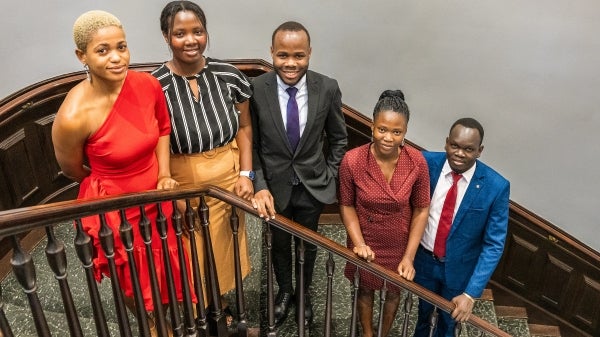Airline travel in the post-COVID-19 era has been a hassle.
More flights are getting canceled. Travel is more expensive with fewer choices to get to and from destinations. Fights are breaking out on board. Take your pick. Going to and from a destination seems to bring forth a whack-a-mole of issues.
This past summer was especially rough, with several instances of travel snafus, including thousands of flights canceled or grounded over bad weather and wildfires, system and IT failures, lost luggage and crews that didn’t show up.
What has happened to our airlines?
Arizona State University’s Lee McPheters not only has some answers but historical context.
ASU News spoke to McPheters, a research professor and director of the JPMorgan Chase Economic Outlook Center in ASU’s W. P. Carey School of Business, to discuss the airline industry’s recent woes and how to fix them.
Lee McPheters
Question: Is it me, or has the airline industry seriously gone downhill these days?
Answer: We need to broaden the focus to the past 25 years. Airlines were severely affected by this century’s three most impactful periods. After the 2001 terrorist attack of 9/11, airline security and the air travel experience also changed, leading to five consecutive years of losses. Next came the Great Recession, with huge losses in 2008 extending into 2009.
Most recently, after 10 years of slow recovery in profits, the pandemic brought an airline travel collapse, financial losses and labor force downsizing. Then in 2022, people wanted to fly again, bringing a summer surge when staffing and equipment were in short supply, resulting in delays, cancellations and frustration, especially in the 2022 holiday season. So what we are seeing right now is the airline industry working as fast as it can to adjust to a catastrophic downturn.
Q: Several things seem to have contributed to the airline industry’s woes. Let’s start with airline pilots. They and crew members are in short supply. What happened to them?
A: Looking again at the big picture, some 10,000 baby boomers turn 65 every day and are eligible for retirement. Under current regulations, many continue to work, but airline pilots do not have that option, so senior pilots are leaving. During the pandemic, many pilots and other airline workers retired voluntarily or switched jobs with more normal work schedules. Industry analysts warn that 50% of current pilots will retire in the next 15 years, so there will be a gap of maybe 15,000 pilot jobs by around 2030.
Pilots and mechanics are not easy to replace because they require extensive training and certification. Flight schools are expanding to meet demand, but pilot training (can cost) up to $100,000 for a complete program, so some airlines subsidize recruits. Meanwhile, airlines are offering various pay incentives to attract workers, and airline total employment is up now by more than 8% compared to pre-COVID 2019.
RELATED: ASU degree programs offer a flight plan for COVID-19 air travel recovery
Q: Southwest Airlines, one that enjoyed a stellar reputation for decades, was embarrassed in December because they lacked the software to keep up with flight schedules. Can you explain what happened, if they’ve corrected the problem and are other airlines following suit?
A: As air travel began to rebound in 2022, airlines had to scramble to be sure crews and aircraft were available to meet the higher demand. In December of 2022, the cancellation rate for airlines topped 5% — and normal is more in the range of 2%. Even though these percentages are small, they translate into over 30,000 flights canceled in December, and 54% were Southwest flights.
In Senate hearings, Southwest executives said that bad weather and outdated technology combined to cause cancellations. The main problem was the crew scheduling system. There were reports that the airline was scheduling crews manually amid the crisis. Southwest has pledged to commit more than $1 billion of its annual operating budget to IT upgrades, and that started earlier this year.
Q: Jet fuel is also way up, contributing to high airline ticket prices and changing many established routes. Will this eventually come down, or is this our new reality?
A: Fuel is one of the highest operating costs for airlines, accounting for 30% to 40% of the cost of a flight. Think of a 747 that holds 60,000 gallons of jet fuel; at July prices of $2.45 a gallon, refueling just one plane is about $147,000. Fuel cost is down a dollar a gallon from a year ago, so it is no wonder airline ticket prices spiked in 2022. But as fuel costs have come down, airfares are down almost 20% from a year ago, too.
Q: Any other issues the airlines face that I didn’t address?
A: Airlines recognize that each flight is a significant source of carbon emissions. The airline industry has committed to a path to net-zero emissions by 2050. Optimization of routes and operational efficiency can help, but the main answer is the development of sustainable aviation fuel (SAF), which is already available but in limited supply. The persistent problem is similar to what we see in so many industries. As of now, fossil fuels are significantly cheaper than SAF. Airlines and the fuel industry hope to overcome this impasse by 2030, but this is a real challenge.
Q: How can the industry get back on its feet and start instilling confidence again?
A: Passenger traffic is recovering, and industry projections show that the airlines will be profitable this year after considerable losses in 2020. So from the corporate perspective, things are looking up. From the consumer side, there is still a lot of frustration with long lines, delayed flights and what seems to be shrinking legroom and seat size. Air travel is a hassle in the eyes of many American consumers.
The time has come for airlines to invest some of those expected profits into innovations and technology that will improve the overall travel experience, whether you are in the first-class cabin or sitting in the center seat back in row 32.
Top photo courtesy Pixabay
More Business and entrepreneurship

ASU, Ghana partnership enhances supply chain practices in Africa
As a New American University, ASU defines the communities it serves as including both its backyard neighbors and colleagues around the world. For the past four years, Arizona State University…

Cohort of Mastercard Foundation Scholars poised to become AI leaders in Africa
Arizona State University is celebrating a significant milestone in expanding the university’s global access mission by welcoming the newest cohort of Mastercard Foundation Scholars, who will…

Networking event turns pitches into partnerships
Perfect timing, quick decisions and electrifying energy are vital aspects of both startup ventures and auctions. In an environment where every moment matters, everyone is searching for the deal that…

